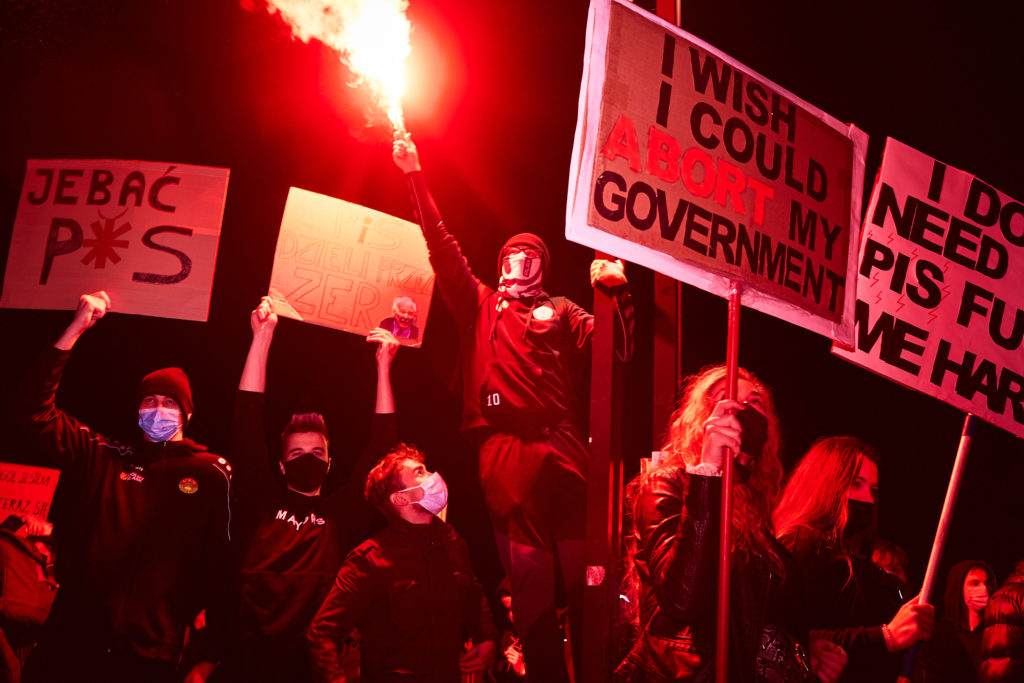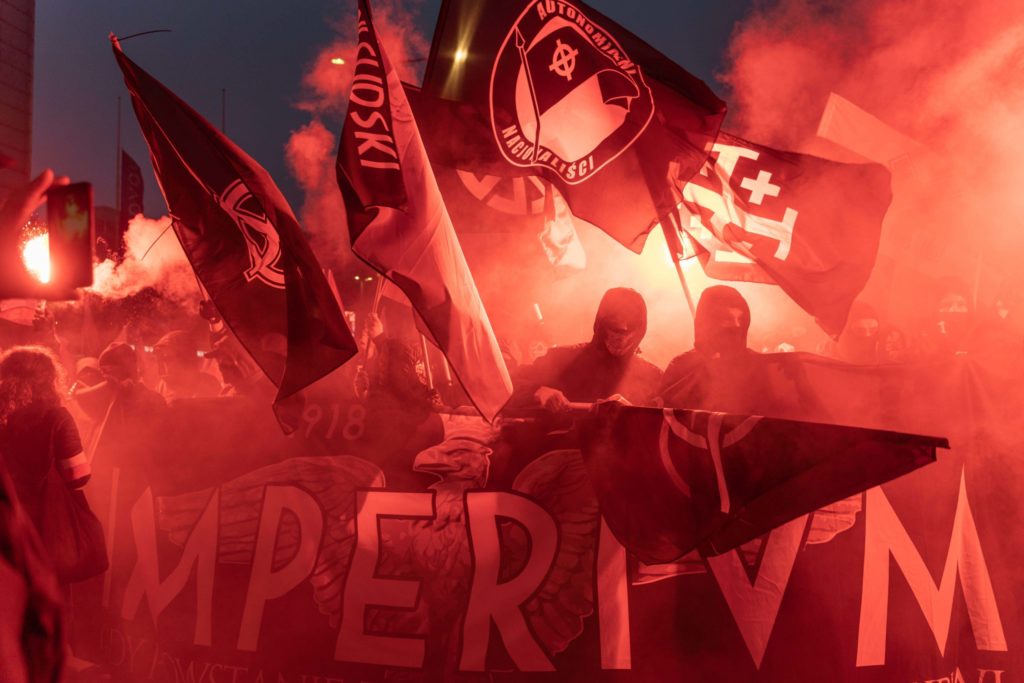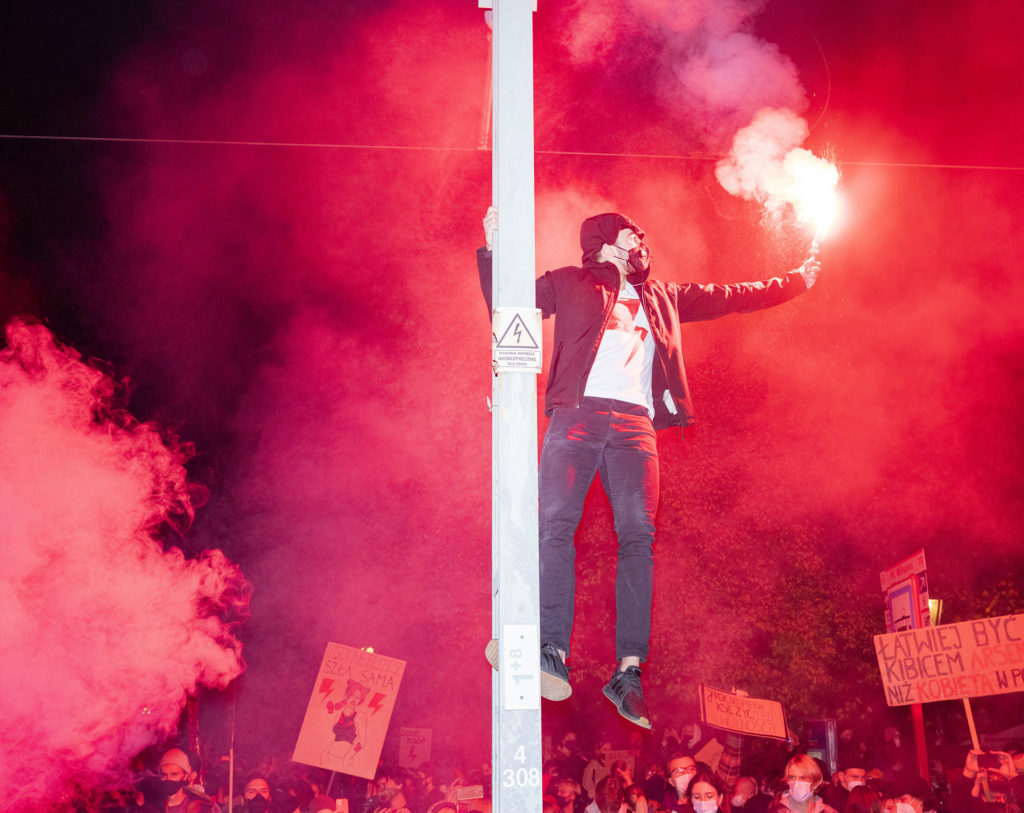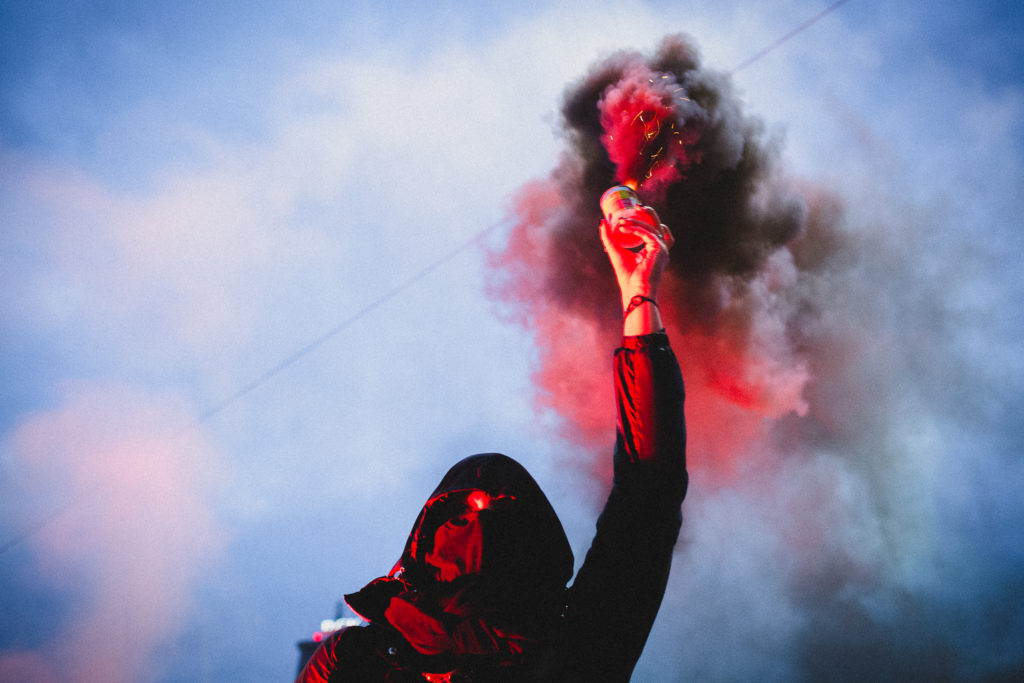Where There’s Smoke, There’s Fire, 2021
Warsawa
Seven months into the pandemic, Polish streets suddenly flooded with protesters opposing the Constitutional Tribunal’s decision to restrict legal abortion. Anger, disappointment, and hopelessness surmounted the fear of the virus, mobilizing Polish citizens to manifest our growing discontent with the government and advocate for their freedom. The emptiness and stagnation of public spaces were abruptly disrupted by the massive crowd and its clamor, bringing life to the deserted concrete landscape.
Although the fierceness of the crowd’s fury was foremost, there were still glimpses of joy, delight, and hope which countered those negative feelings. After months of social distancing and growing isolation, the protests seemed to be breaking not only political chains, but also those of the coronavirus frustration. We went to the streets motivated to fight for our freedom, and, as disappointing as it is, we have not succeeded. Yet, what we found in lieu was a sense of unity, of sharing reality with an unfathomable number of persons, of being a part of something bigger than ourselves – a vibrant community, together in this local and global chaos.

Thomas Hobber wrote in Leviathan that people “asunder are moderate as the heat of one brand, in assembly are like many brands that inflame one another.”[1] This unity was most visually manifested by flares and colorful smoke bombs, hand-fired in the crowd. Always welcomed with hearty cheers, shouts, roars, the voicing of sheer elation, flares initiated a flow of upbeat energy within protesters. All of a sudden, the world was no longer dull and grim. With this visual incentive, it was easier to believe that there was still light and color, or hope and joy, dispersing through the crowd like the smoke from flares above it.

In a sense, flares have guided us emotionally, both bringing our awareness to the atmosphere of the protest and distracting us from it with their mesmerizing ephemeral brightness and colorfulness. Used for signaling on railroads, highways, and in airports, flares’ attention-grabbing quality kept us on the track of resistance against the government’s disrespect of Polish citizens. Hence, they could be perceived not only as guides, but also as an attribute of one—namely, of the crowd, which directs a shift in collective thinking, strenuously disapproves of the government’s perfidy, and steers the path of social responsibility. The burn of flares became a symbolic spark of a cleansing fire of change, blazing in the minds of Poles united against injustice.
However, in the Polish context, flares can have right-wing and conservative associations, with nationalists thronging the streets during one of the most important Polish celebrations—the National Independence Day. As stated by OKO.press, Polish independent press, for the past few years, the annual March for Independence organized on November 11th has become a “show of power for nationalists and neofascists from all over the Europe.”[2] Every year streets of Warsaw are being covered with the red gleam of flares, overwhelming in their excess, at times marred by violence. In this context, flares are associated with a disturbing demonstration of power and aggression, which poses a threat and produces a profound sense of fear.
Although there is controversy around the media coverage of this holiday—some sources frame the bursts of aggression as incidental—the march itself cannot be called a peaceful expression of patriotism.[3] In 2020, two weeks after the peak of the Women’s Strike protests, nationalists gathered again under the guise of celebrating the restoration of Polish sovereignty in 1918, adopting the phrase “Nasza cywilizacja, nasze zasady” (“Our civilization, our rules”) as their slogan. Guided by these words, nationalists tried to fend off the new preeminence of left-wing voices by reclaiming the same streets where Polish citizens defended democracy and women’s rights. Like before, the burn of illegal flares emblazed the public space, which became the arena of political strife more apparently than ever before.[4] And yet, the sight of these flares felt nothing like those fired during the Women’s Strike protests. While the March for Independence is associated with a relatively hermetic nationalist circle, the protests, as previously mentioned, brought together people from all over Poland: those from different age groups, genders, backgrounds, and even of different political views. The flares burnt during the protests, although just as illegal as those burnt during the March, reinforced the atmosphere of rebellion by taking control of rowdy artefacts and harnessing the fear evoked by nationalists’ performance.

Nevertheless, flares also evoke these feelings independently of the above associations. Once the flare is set off, the initial gut reaction is that of shock, and also of unrest—the body braces itself for combating a threat, finding itself briefly in a state of jeopardy. This fleeting sense of fear when seeing a flare during the protest is one of the crucial aspects of their effect, for it evokes certain arousal and initiates a surge of adrenalin in the bloodstream. And this contributes to the rush of strong emotions in every protestor, which sometimes results in their adverse expression and acts of vandalism. This was also the case during the protests, when people let themselves be carried away by insurgent momentum, and did things they usually would not do in the public space, such as spraying graffiti or swearing.

Considering the above, the role of flares in the context of protests seems all the more meaningful. Flares and color smokes epitomized all of the contradictory emotions felt while we were taking over the streets of Warsaw (and other towns and cities). They helped the crowd to channel its feelings and release them; to express the anger, the danger, the disappointment. They made us feel powerful and fearless, even only for a few seconds of their fleeting presence. Although usually fired by hooligans, during the protests they became an attribute of citizens enraged by their government, and, by the same token, flares stood for a kind of civil disobedience, playing a role in the reappropriation of the public space.
Given that flares are commonly used as distress signals, their use during the protests could also be seen as a certain cry for help. For we did cry for help. We did cry to be seen, heard, and respected. A substantial number of Polish citizens found themselves on the verge. Despite the pandemic, people have chosen to coalesce in the street, and doggedly manifest their objection. Before every protest, we exchanged phone numbers of potential advocates, who would have defended us if had we been taken by the law enforcement, which happened on occasion. With numbers written on our arms, we felt as much terrified as angry. We were motivated enough to push back the boundaries of public conduct, swearing and burning flares. While we meant no harm, the flares have become a symbolic weapon against the darkness which descends when democracy fades. As one of the main slogans for the protest said, “To jest wojna!” (“This is war!”).

[1] Thomas Hobbes, Leviathan or The Matter, Forme and Power of a Commonwealth Ecclesiasticall and Civil (London, 1651), https://socialsciences.mcmaster.ca/~econ/ugcm/3ll3/hobbes/Leviathan.pdf., p. 160-161.
[2] “Marsz Niepodległości,” OKO.press, accessed March 26, 2021, https://oko.press/tag/marsz-niepodleglosci/.
[3] In 2017, after a particularly violent March for Independence came to the attention of international press, Polish Ministry of Foreign Affairs released a statement, in which it was said that “imputing that the march was dominated by the elements whose nature was purely incidental is unwarranted” (source: https://wyborcza.pl/7,75398,22638487,msz-marsz-niepodleglosci-byl-wielkim-swietem-polakow.html). Furthermore, after European Parliament’s condemnation of the march, President Duda claimed that while indeed, there are certain incidents that should not take place, such assessment of the march for him is unacceptable, claiming that the vast majority of participants came to merrily express their patriotic feelings. (source: https://www.prezydent.pl/aktualnosci/wypowiedzi-prezydenta-rp/wywiady/art,130,wywiad-prezydenta-dla-dziennika-gazety-prawnej.html).
[4] At the beginning of the year 2020, Robert Bąkiewicz who is one of the organizers of the march stood trial for the insufficient safety measures when it comes to the participant’s use of pyrotechnics. Bąkiewicz claimed that the accusations are “absurd” and that people who break the law (as the use of flares is illegal) are being turned out. Yet, the use of flares during the march is notorious and has become and integral part of the “celebration.” (source: https://oko.press/kto-odpalil-nielegalne-race-prezes-marszu-niepodleglosci-to-policja-nie-dopilnowala/)